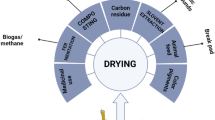Abstract
Brewery spent grain represents approximately 85 % of total by-products generated in a brewery. Consisting of carbohydrates, fiber, minerals and low amounts of protein, the use of brewery spent grain is limited to the feeding of ruminants; however, its potential use should be investigated. The reuse of this by-product using microorganisms by solid-state fermentation process as the case of protein enrichment by single-cell protein incorporation is an alternative to ensure sustainability and generate commercially interesting products. In this context, the aim of this study was to grow Rhizopus oligosporus in brewery spent grain under different initial moisture contents and nitrogen sources to increase the protein content of the fermented material. After 7 days of fermentation, increase of 2–4 times in the crude protein and soluble protein content was verified, respectively, compared to unfermented brewery spent grain. The kinetics of protein enrichment demonstrated the possibility of application of this technique, which can be a great alternative for use in diets for animals.






Similar content being viewed by others
References
Mussatto SI (2014) Brewer’s spent grain: a valuable feedstock for industrial applications. J Sci Food Agr 94:1264–1275
Steiner J, Procopio S, Becker T (2015) Brewer’s spent grain: source of value-added polysaccharides for the food industry in reference to the health claims. Eur Food Res Technol 241:303–315
Aliyu S, Bala M (2011) Brewer’s spent grain: a review of its potentials and applications. Afr J Biotechnol 10(3):324–331
Villas-Bôas SG, Esposito E, Mitchell DA (2002) Microbial conversion of lignocellulosic residues for production of animal feeds. Anim Feed Sci Tech 98:1–12
Bernardi E, Donini LP, Minotto E, Nascimento JS (2007) Utilização de diferentes substratos para a produção de inóculo de Pleorotus ostreatoroseus Sing. Rev Cienc Agron 38(1):84–89
Oliveira MA, Donega MA, Peralta RM, Souza CGM (2007) Produção de inóculo do cogumelo comestível Pleurotus pulmonarius (Fr.) Quélet—CCB19 a partir de resíduos da agroindústria. Cienc Tecnol Alime 27:84–87
Silveira CM, Furlong EB (2007) Caracterização de compostos nitrogenados presentes em farelos fermentados em estado sólido. Cienc Tecnol Alime 27(4):805–811
Vendruscolo F, Ribeiro CS, Esposito E, Ninow JL (2009) Protein enrichment of apple pomace and use in feed for Nile tilapia. Appl Biochem Biotech 152:74–87
Kumar A, Kanwar SS (2012) Lipase production in solid-state fermentation (SSF): recent developments and biotechnological applications. Dyn Biochem Process Biotechnol Mol Biol 6:13–27 (ISSN 1749-0626)
Bisaria R, Madan M, Vasudevan P (1997) Utilization of agro-residues as animal feed through bioconversion. Bioresour Technol 59:5–8
Miranda JC (2014) Bioconversão energética da folha e bagaço de mandioca pelo fungo Rhizopus oligosporus para obtenção de alimento funcional. Master Thesis, Universidade Estadual Paulista Júlio de Mesquita Filho, Rio Claro, p 77
Sabu A, Sarita S, Pandey A, Bogar B, Szakacs G, Soccol CR (2002) Solid-state fermentation for production of phytase by Rhizopus oligosporus. Appl Biochem Biotech 102–103(1–6):251–260
Araújo KB, Santos RCA, Souza FM, Aquino LCL (2011) Protein enrichment of mangaba seed flour with Rhizopus oryzae: optimization using the response surface methodology. Tecnol Ciênc Agropec 5(4):45–50
Bourdichon F, Casaregola S, Farrokh C, Frisvad JC, Gerds ML, Hammes WP, Harnett J, Huys G, Laulund S, Ouwehand A, Powell IB, Prajapati JB, Seto Y, Schure ET, Boven AV, Vankerckhoven V, Zgoda A, Tuijtelaars S, Hansen EB (2012) Food fermentations: microorganisms with technological beneficial use. Int J Food Microbiol 154:87–97
AOAC (2005) Official Methods of Analysis. 15 ed
FAO (2003) Food energy—methods of analysis and conversion factors, Rome. http://www.fao.org/uploads/media/FAO_2003_Food_Energy_02.pdf. Accessed 05 September 2014
Lowry OH, Rosebrough NJ, Farr AL (1951) Protein measurement with the folin phenol reagent. J Biol Chem 193:265–275
BRAZIL (2013) Compêndio brasileiro de alimentação animal. Sindirações
Aidoo KE, Hendry R, Wood BJB (1981) Estimation of fungal growth in a solid state fermentation system. Eur J Appl Microbiol Biotech 12:6–9
Hsu PK, Liu CP, Liu LY, Chang CH, Yang SS (2013) Protein enrichment and digestion improvement of napiergrass and pangolagrass with solid-state fermentation. J Microbiol Immunol 46:171–179
Vendruscolo F, Ribeiro CS, Espósito E, Ninow JL (2009) Tratamento biológico do bagaço de maçã e adição em dietas para alevinos. R Bras Eng Agríc Ambient 13(4):487–493
Campos ARN, Santana RAC, Dantas JP, Oliveira LSC, Silva FLH (2005) Enriquecimento proteico do bagaço do pedúnculo de caju por cultivo semi-sólido. Rev Biol Ciênc Terra 5(2):1250–1253
Ogunjobi AA, Mejeha OK, Fagade OE (2011) Protein enrichment of brewery spent grains using Aspergillus oryzae. AU J Technol 15(1):53–56
Lima T (2009) Modelo de inferência para a estimação da umidade do leito de um biorreator de fermentação no estado sólido. Master thesis, Universidade Federal do Paraná, Curitiba, p 166
Lareo C, Sposito AF, Bossio AL, Volpe DC (2006) Characterization of growth and sporulation of Mucor bacilliformis in solid state fermentation on an inert support. Enzyme Microb Tech 38:391–399
Suhet MI, Fioreze R (2011) Produção de proteína unicelular a partir do resíduo da industrialização do abacaxi utilizando fermentação em estado semisólido. Rev Bras Tecnol Agroind Ponta Grossa 5(2):584–592
Dragone G (2007) Fermentação primária para produção de cervejas de altas densidades por processo contínuo utilizando leveduras imobilizadas em bagaço de malte. PhD thesis, Universidade de São Paulo, Lorena, p 140
Acknowledgments
The authors wish to thank the Conselho Nacional de Desenvolvimento Científico e Tecnológico (CNPq—The National Council for Scientific and Technological Development) for financial support (Process Number 444241/2014-0), the Coordenação de Aperfeiçoamento de Pessoal de Nível Superior (CAPES—Committee for Professional Development of Higher Education Staff) for a research scholarship, and the Reall Chopp for brewery spent grain donation.
Author information
Authors and Affiliations
Corresponding author
Rights and permissions
About this article
Cite this article
Canedo, M.S., de Paula, F.G., da Silva, F.A. et al. Protein enrichment of brewery spent grain from Rhizopus oligosporus by solid-state fermentation. Bioprocess Biosyst Eng 39, 1105–1113 (2016). https://doi.org/10.1007/s00449-016-1587-8
Received:
Accepted:
Published:
Issue Date:
DOI: https://doi.org/10.1007/s00449-016-1587-8




